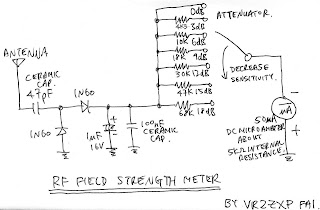 This RF remote control is useful to handle some electric device. If you want to control your garage door, the only way is to use some RF remote control. The transmitter-receiver circuit use few components and ordinary. It's easy to build it because you don't have to tune-up any coil or variable capacitor. The RF modules are fix to work in 418MHz area.
This RF remote control is useful to handle some electric device. If you want to control your garage door, the only way is to use some RF remote control. The transmitter-receiver circuit use few components and ordinary. It's easy to build it because you don't have to tune-up any coil or variable capacitor. The RF modules are fix to work in 418MHz area.Remote Control Design Consideration
- The check of the received data because many other devices are working in this frequency (418MHz)
- The power-saving of the transmitter. One transmitter must have battery long-life, there is not good to change the battery after 3 days ;) . I don't care about the receiver`s power supply, because receiver must be working all the time.
Remote Control Features:
Transmitter
- Standby: <1uA (less than 1 microampere)
- only 3v power supply
- 10...15m distance range
- 2400bps communication
- 2 initial bytes for device recognition (ID bytes) calculate the checksum of the sended data (to avoid fake commands)
- few components
- small size
The transmitter is constituted by AT90S2323 microcontroller and TLP434 RF transmitter module at 418MHz. I have designe the transmitter for more battery economy and safe transmition of the data.
- The battery economy is made it by the use of powerdown mode of AVR. In this case the AVR goes to sleep with less than 1uA (microampere) current and wait for external interrupt on pin PB1 to awake from sleep and continue operating.
- If you press the S2 key, the logic of this pin goes to '0' (0V) and AVR awake frome the sleep mode (because PB1 is INT0) and check if pressed the S1 key. If not, the AVR take as pressed key the S2. If yes the AVR take as pressed key the S1. If you press the S1 key the logic of this pin and PB1 (through 1N4148) goes to '0' (0V). In this case the AVR take as pressed key the S1.
- After, calculate the checksum and transmit 4 times the same 4 byte sequence to make sure that receiver takes the data and goes to sleep mode until next interrupt on PB1. When the INT0 pin (PB1) of AVR goes to 0V, the transmitter TLP434A is working. If you stop press the switch S1 or S2, the TLP is stop working.
- The safe transmition of the data based to transmition of 4 bytes with serial form at 2400 bps (bits per seconds). 1st and 2nd byte are for recognition of valid remote control from receiver (like ID bytes), 3rd byte is command byte. The relays status dependet by the value of this byte. Finaly, the 4th byte is the checksum of the earlier 3 bytes.
As antenna you can use ~7cm cable in to transmitter`s box
Receiver
- Hardware UART at 2400bps
- 4 bytes (32bit) length communication
- checksum of the received bytes (to avoid fake commands)
- few components
- smal size
The receiver constituted by RF receiver module RLP434A at 418MHz, the microcontroller AT90S2313 and the 2 relays with can handle any electric (or electronic) device up to 10 Amps (the contacts of my relays are 10Amp at 250Volts).
The RLP434A is an RF receiver module with receipt frequency at 418MHz with ASK modulation. There are 2 outputs from this module, the digital, with levels from 0v to VCC (5 volts in our case) and the analog output. Analog output is not used. The transmitter send 4 bytes with 2400bps 4 times and the receiver RLP-434A, collect them and move them to AT90S2313 to RxD pin, PD0.
Two reasons to select AT90S2313 (20pins) instead of AT90S2343 (8pins) is because
- AT90S2313 use a hardware UART adjusted at 2400bps and the hardware UART is more stable, with smaller code, than software UART that I use in the transmitter. If some serial data arrive at the middle-time of some other routine other than receive routine, for sure we will loose this bits of data. The hardware UART does not have this problem because have buffer for this (UDR register). This is what I mean that the hardware UART is "stable".
- With AT90S2313 we can drive up to 14 relays with future upgrade of the firmware, one relay to each pin.
Power Supply for Receiver
The power supply of RF receiver constituted by 2 voltage regulator, LM7812 and LM7805. The first (12V) its only to power the 2 relays and the 2nd (5V) to power the AVR microcontroller and the RF receiver module. The LED, is voltage indicator and the 4 capacitors are to flattening the voltage.
Usage of Ttransmitter
Power on the receiver and press S1 key to transmitter. You will see that relay on PB0 of receiver will arm. If you press one more time the same key, the relay will dissarm. If you press S2 key from transmitter you will see that relay on PB1 of receiver will arm. If you press one more time the same key, the relay will dissarm. Each key is for 1 relay only.
I choose to drive 2 relays and not only 1 because for some application like garage door 1 relay can handle the door (open-close) and the other to turn-on or off the light of the garage.
Click here to download the firmware, source code and schematic for AT90S2313 and AT90S2323 microcontrollers
The RF modules TLP434A and RLP434A are from Laipac
Source: 2 Channels RF Remote Control




















































